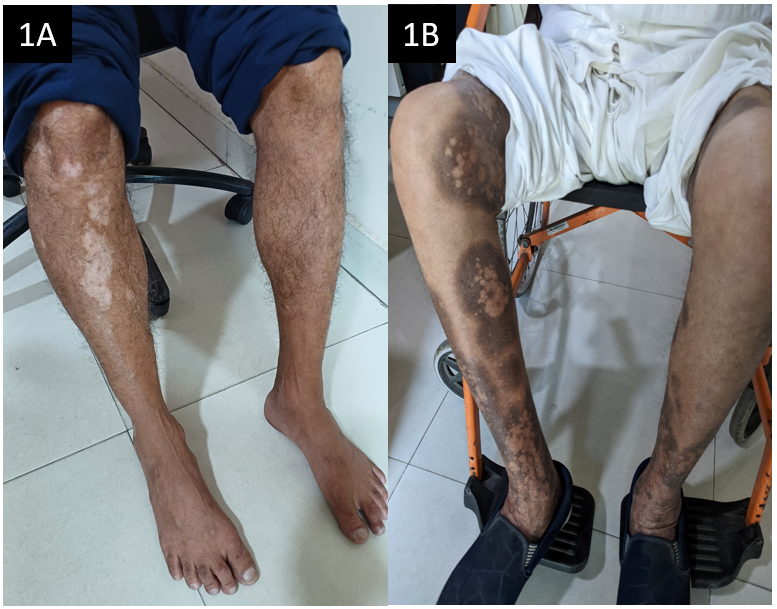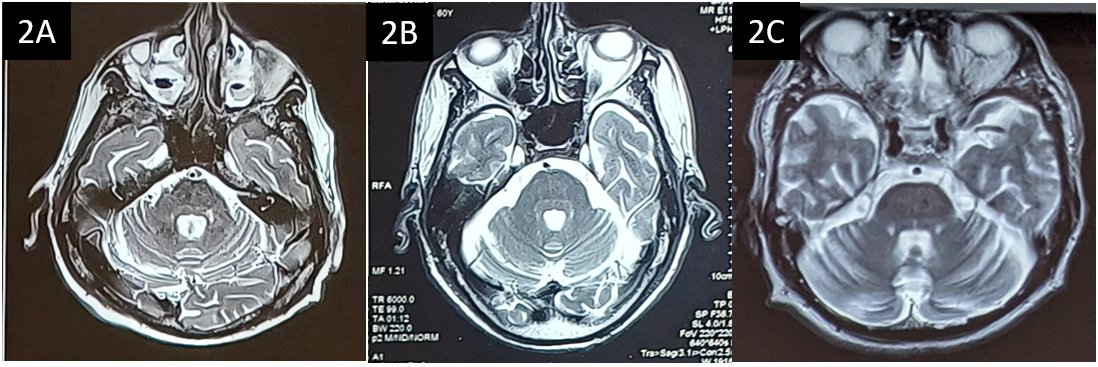Category: Ataxia
Objective: Delineation of clinical and genetic features of Spinocerebellar ataxia 45 (SCA45) in three families of Indian origin.
Background: SCA45 has been reported in few Brazilian and European cohorts, caused by FAT2 (FAT Atypical Cadherin 2) variants [1,2]. Previously, we have reported it in an Indian family [3]. Late-onset isolated cerebellar ataxia is the commonest presentation of SCA45 reported in the literature, while a single case presented with cerebellar ataxia, neuropathy, vestibular areflexia (CANVAS) phenotype [4]. SCA6 and multisystem atrophy-cerebellar type (MSA-C) are common differentials.
Method: We assessed clinical, radiological and genetic data of 5 patients of SCA45 from 3 families, attended the movement disorder clinic at Institute of Neurosciences Kolkata (I-NK).
Results: On the family, seen by us most recently, the index case started having gait ataxia in 61 years of age. There was asymmetric dysmetria (left > right), dysarthria, but no nystagmus. He had hypopigmented skin rash in legs [figure1A]. MRI showed diffuse cerebellar atrophy [figure2A]. His mother and brother, both had similar symptom onset in early 60s. Brother had more symmetric pan-cerebellar syndrome. c.8911A>C variant in FAT2 was present in the index case and his brother.
On the second family, the index case had predominant gait ataxia since the age of 73 year along with bilateral postural and action tremor and subtle dysmetria, no nystagmus. SCA12 genetics was negative. MRI showed diffuse cerebellar atrophy [figure2B]. Exome sequencing revealed c. 3558G>T variant in FAT2. His mother had similar symptoms, starting in late 70s.
On the third family, reported by us previously, the index case presented with slowly progressive gait ataxia since the age of 62, along with gaze-evoked nystagmus, dysmetria and dysarthria. His mother, four of his elder brothers and two nieces had late onset gait ataxia. The only surviving elder brother, seen by us, had pan-cerebellar syndrome with onset in late 70s. Additionally, both of them had sensorineural hearing loss and the index case had bullous pemphigoid [figure1B]. Both had diffuse cerebellar atrophy [figure2C] and c.5114T>C variant in FAT2 gene.
Conclusion: SCA45 should be suspected in patients with late-onset familial cerebellar ataxia when traditional SCA expansion panel is negative. Dermatological manifestations may provide an additional clinical clue.
References: [1] Tonholo Silva TY, Rosa ABR, Quaio CR, Verbeek D, Pedroso JL, Barsottini O. Does SCA45 Cause Very Late-Onset Pure Cerebellar Ataxia? Neurol Genet. 2021 Mar 26;7(3):e581. doi: 10.1212/NXG.0000000000000581.
[2] Nibbeling EAR, Duarri A, Verschuuren-Bemelmans CC, et al. Exome sequencing and network analysis identifies shared mechanisms underlying spinocerebellar ataxia. Brain. 2017 Nov 1;140(11):2860-2878. doi: 10.1093/brain/awx251.
[3] Ganguly J, Mukherjee S, Basu P, Mondal B, Chatterjee K, Roy A, Pande P, Kumar H. Think of SCA45 in Late-Onset Familial Ataxias: The First Report from the Indian Subcontinent with a Novel Variant. Mov Disord Clin Pract. 2022 Oct 10;9(8):1140-1143. doi: 10.1002/mdc3.13580.
[4] Rafehi H, Szmulewicz DJ, Bennett MF, et al. Bioinformatics-Based Identification of Expanded Repeats: A Non-reference Intronic Pentamer Expansion in RFC1 Causes CANVAS. Am J Hum Genet. 2019 Jul 3;105(1):151-165. doi: 10.1016/j.ajhg.2019.05.016.
To cite this abstract in AMA style:
J. Ganguly, P. Basu, B. Mondal, H. Kumar. Genetic and phenotypic characterization of ATX-FAT2 (SCA45) in three Indian families [abstract]. Mov Disord. 2023; 38 (suppl 1). https://www.mdsabstracts.org/abstract/genetic-and-phenotypic-characterization-of-atx-fat2-sca45-in-three-indian-families/. Accessed April 20, 2025.« Back to 2023 International Congress
MDS Abstracts - https://www.mdsabstracts.org/abstract/genetic-and-phenotypic-characterization-of-atx-fat2-sca45-in-three-indian-families/


